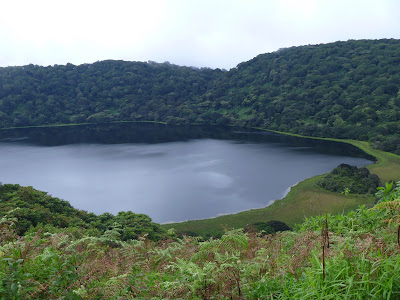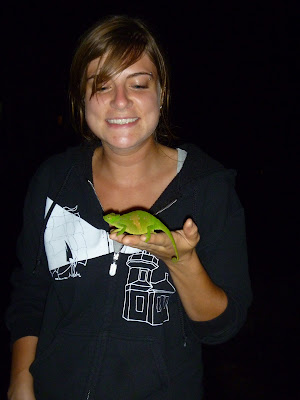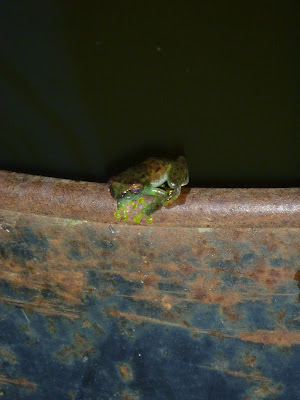The day after our MEGI mom lunch, we packed our bags and headed to Moka for the first part of our Field Methods class. It was a great week…
Accommodations
The first time we went to Moka we slept in the research station building. This time, there were 10 of us including the 5 UNGE students, so we set up shop in tents behind the visitor’s center. The bathroom is inside the visitor’s center, but there isn’t any running water. We have to flush the toilet with a bucket of water from the barrels outside that collect rainwater (it rains a ton in Moka). We have to shower out of a bucket, too. First we heated the water over the fire then took it over to the wooden stall behind the building that was the “shower.” It wasn’t bad at all, none of us showered that often during the week anyway! We had reached what we deemed “critical stank,” and we were perpetually dirty. There’s no way to avoid it. During the day, there isn’t any electricity, but after dinner the generator gets turned on so there are lights and internet.
The first time we went to Moka we slept in the research station building. This time, there were 10 of us including the 5 UNGE students, so we set up shop in tents behind the visitor’s center. The bathroom is inside the visitor’s center, but there isn’t any running water. We have to flush the toilet with a bucket of water from the barrels outside that collect rainwater (it rains a ton in Moka). We have to shower out of a bucket, too. First we heated the water over the fire then took it over to the wooden stall behind the building that was the “shower.” It wasn’t bad at all, none of us showered that often during the week anyway! We had reached what we deemed “critical stank,” and we were perpetually dirty. There’s no way to avoid it. During the day, there isn’t any electricity, but after dinner the generator gets turned on so there are lights and internet.
Food
Every morning we bought a bunch of freshly baked bread from a Bubi woman in the village. For breakfast and lunch we had that bread, the Cameroonian not-quite-as-delicious equivalent of Nutella called Tartina, President spreadable cheese wedges, Spam, sardines, tuna, and olives. All the food in Moka has to be non-perishable. There’s a tiny refrigerator, but it’s only on when the generator’s on. Also, there isn’t really anywhere to buy fresh vegetables or fruits (although one day we were lucky to get bananas from a tree since they’re everywhere). I got a little sick of these choices by the end of our time in Moka, but it was alleviated by the delicious food we had for dinner. We hired two Bubi women (so many Bubi/booby jokes that week…) to cook dinner for us every night. They always made some combination of rice, pasta, beans, lentils, potatoes, green beans, or cabbage. It was delicious every time, especially with some mayo (I am turning so Guinean) and spicy red pepper flakes.
Every morning we bought a bunch of freshly baked bread from a Bubi woman in the village. For breakfast and lunch we had that bread, the Cameroonian not-quite-as-delicious equivalent of Nutella called Tartina, President spreadable cheese wedges, Spam, sardines, tuna, and olives. All the food in Moka has to be non-perishable. There’s a tiny refrigerator, but it’s only on when the generator’s on. Also, there isn’t really anywhere to buy fresh vegetables or fruits (although one day we were lucky to get bananas from a tree since they’re everywhere). I got a little sick of these choices by the end of our time in Moka, but it was alleviated by the delicious food we had for dinner. We hired two Bubi women (so many Bubi/booby jokes that week…) to cook dinner for us every night. They always made some combination of rice, pasta, beans, lentils, potatoes, green beans, or cabbage. It was delicious every time, especially with some mayo (I am turning so Guinean) and spicy red pepper flakes.
Daily Routine
We were in Moka for the first half of our Field Methods class. What we mostly did was census of the monkeys and other mammals, and one day we marked a trail every 20 meters with flagging tape. Every morning we woke up around 8, had some breakfast, and left for a hike around 8:30. Each trail was about 4 km, and we had to hike back, too. So each day we hiked the trail at a slow pace in order to spot mammals. Sadly we found more shotgun shells and animal traps than actual animals. Hunting the monkeys is illegal, but there is zero enforcement so it is, unfortunately, still prevalent. We saw a lot of squirrels, a couple monkeys (I really only saw a quick flash), and heard a duiker or two. I thoroughly enjoyed the hikes, but they were definitely a work out. We hiked 4 km on average, which was the easy part since we had to go slow for our census, but then we had to hike the 4 km back which was always harder because it tended to be uphill. After hiking we usually wolfed down some lunch and relaxed for the rest of the day. At night we ate dinner around the fire and stayed there for the rest of the night. Moka gets chilly so it was really nice.
We were in Moka for the first half of our Field Methods class. What we mostly did was census of the monkeys and other mammals, and one day we marked a trail every 20 meters with flagging tape. Every morning we woke up around 8, had some breakfast, and left for a hike around 8:30. Each trail was about 4 km, and we had to hike back, too. So each day we hiked the trail at a slow pace in order to spot mammals. Sadly we found more shotgun shells and animal traps than actual animals. Hunting the monkeys is illegal, but there is zero enforcement so it is, unfortunately, still prevalent. We saw a lot of squirrels, a couple monkeys (I really only saw a quick flash), and heard a duiker or two. I thoroughly enjoyed the hikes, but they were definitely a work out. We hiked 4 km on average, which was the easy part since we had to go slow for our census, but then we had to hike the 4 km back which was always harder because it tended to be uphill. After hiking we usually wolfed down some lunch and relaxed for the rest of the day. At night we ate dinner around the fire and stayed there for the rest of the night. Moka gets chilly so it was really nice.
Independence Day
Wednesday the 12th was our day off since it was independence day for the UNGE kids, aka the anniversary of the day president Obiang overthrew his uncle who was in power before him. Although there aren’t veggies anywhere in Moka, there is no such thing as a place with no beer in EG. Every little village has at least more than a few bars. So we celebrated independence day in style, but had a sort of rough hike the next day to say the least. We went to the top of the road to see the view of Moka and the sunset. Unfortunately it was incredibly foggy so we didn’t see anything at all, but Karim, Mahmood, and all the Syrians were up there already pretty intoxicated. They were chopping everything in sight down with machetes. It was extremely entertaining and I got to chop shit with a machete too which was just plain fun. I got some lovely group pictures, I’ll try to put them up soon. You really need to see these people to begin to understand the awesomeness.
Wednesday the 12th was our day off since it was independence day for the UNGE kids, aka the anniversary of the day president Obiang overthrew his uncle who was in power before him. Although there aren’t veggies anywhere in Moka, there is no such thing as a place with no beer in EG. Every little village has at least more than a few bars. So we celebrated independence day in style, but had a sort of rough hike the next day to say the least. We went to the top of the road to see the view of Moka and the sunset. Unfortunately it was incredibly foggy so we didn’t see anything at all, but Karim, Mahmood, and all the Syrians were up there already pretty intoxicated. They were chopping everything in sight down with machetes. It was extremely entertaining and I got to chop shit with a machete too which was just plain fun. I got some lovely group pictures, I’ll try to put them up soon. You really need to see these people to begin to understand the awesomeness.
Overall it was an amazing week. I’ve definitely fallen in love with Moka and I am antsy to get back. I’m bored of the city life, although we’ve been having some fun here in Malabo too. I can’t wait until we get back to Moka in a few weeks for our Field Research class where we will carry out our research projects we’ve designed. I personally will be investigating the impact of human disturbance on chameleon density. I’m excited to get started. We’ll do our research for two weeks then join Shaya (our Field Methods instructor) on the southern beaches for the second half of our class, assisting with marine turtle research. I’m really looking forward to that. Shaya told us it’s the most beautiful place she’s ever been so I seriously can’t wait to get there especially since the beach is my favorite place to be.






























